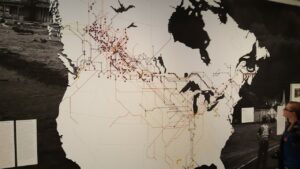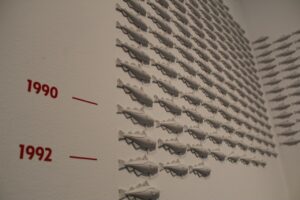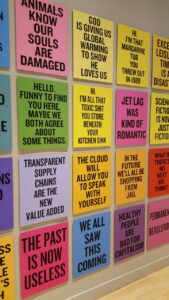by Mauro Agnellini (MCRM ’18)
It wasn’t instantly evident how a SCI 155 outing to the Canadian Centre for Architecture would be related to global environmental earth science. When mentioning an architecture museum, I imagine most people think about the style of buildings, their historical background and the endeavors of the architect. However, we quickly found out that this wasn’t an ordinary architecture museum . . . if anything, this museum highlights how humans seem to be the architects of their own demise.
The main exhibit in the museum was titled, “It’s All Happening so Fast: A Counter-History of the Modern Canadian Environment”. We were handed newspapers that outlined the pieces in the exhibit. What I didn’t realize at the time was that this newspaper, in and of itself, is an art piece because it demonstrates the way we hear about environmental disasters but few ultimately take preventative measures to keep these catastrophes from happening.
The introductory statement is as follows, “A series of stories based on environmental disasters confirm Canada as an exemplary case study in the contrast between romantic ideas of nature and the consequences of human exploitation” (CCA). In this blog post, we’ll explore this juxtaposition and the mentioned stories.
Piece after piece demonstrated Canada’s long history with the environment ranging from the collapse of the cod fishing industry to the plotting of environmental disasters and their aftermaths (pictured below).
This piece collected data dating back to the 1930s, showing the breadth of oil pipelines and spill occurrences in North America. Some of these catastrophes have household recognition in Canada, like the series of Vancouver oil spills or the Lac-Mégantic rail disaster which resulted in 47 deaths and the near destruction of the downtown district.
On the topic of the clash between nature’s romantic qualities and consequences of human exploitation, the collapse of the cod fishing industry in Canada was demonstrated by the piece below:
The over-fishing of cod populations led to the collapse of the industry which sent ripples throughout Canadian social, economic and political circles. The rich 500 year history of this industry was instrumental in the establishment of entire towns along the eastern coast. While studies have shown promising signs of gradual recovery, this industry’s legacy will be tainted after having cod biomass drop below 1% in 1992 (CCA).
Our group was captivated by a piece which featured hard-hitting statements about our environmental impact with references to consumerist culture. Conveyed through glossy pop plaques, strong elements of guilt and permanent damage being dealt to our world were the evident themes.
In conclusion, the CCA provided a new perspective on architecture through poignant pieces related to the environment. As the semester continues, I foresee the themes which were expressed here popping up in our courses and activist projects, prompting further reflection and response in order to influence a tonal shift related to our world.


